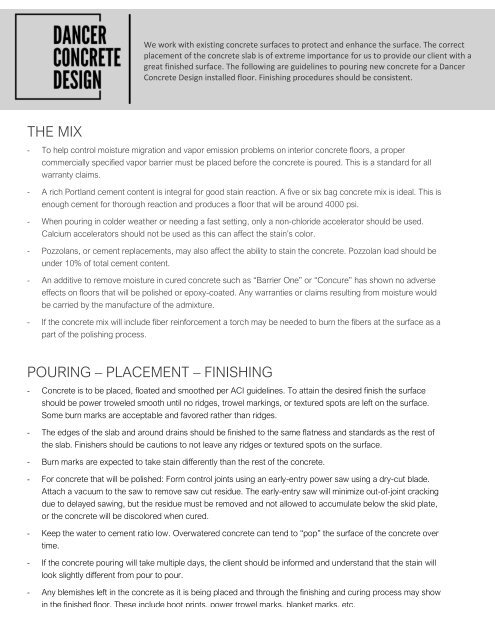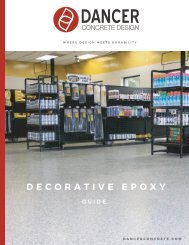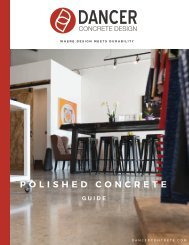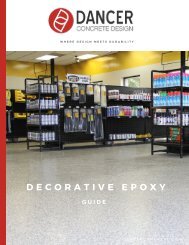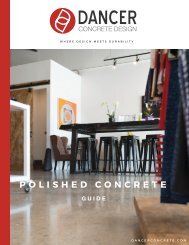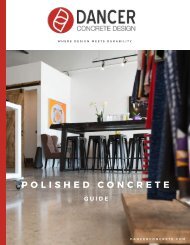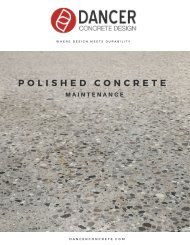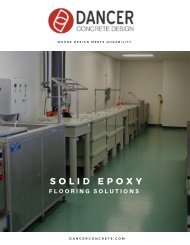Poured Concrete Specifications
Dancer Concrete Design's poured concrete specifications for contractors and clients.
Dancer Concrete Design's poured concrete specifications for contractors and clients.
Create successful ePaper yourself
Turn your PDF publications into a flip-book with our unique Google optimized e-Paper software.
We work with existing concrete surfaces to protect and enhance the surface. The correct<br />
placement of the concrete slab is of extreme importance for us to provide our client with a<br />
great finished surface. The following are guidelines to pouring new concrete for a Dancer<br />
<strong>Concrete</strong> Design installed floor. Finishing procedures should be consistent.<br />
THE MIX<br />
- To help control moisture migration and vapor emission problems on interior concrete floors, a proper<br />
commercially specified vapor barrier must be placed before the concrete is poured. This is a standard for all<br />
warranty claims.<br />
- A rich Portland cement content is integral for good stain reaction. A five or six bag concrete mix is ideal. This is<br />
enough cement for thorough reaction and produces a floor that will be around 4000 psi.<br />
- When pouring in colder weather or needing a fast setting, only a non-chloride accelerator should be used.<br />
Calcium accelerators should not be used as this can affect the stain’s color.<br />
- Pozzolans, or cement replacements, may also affect the ability to stain the concrete. Pozzolan load should be<br />
under 10% of total cement content.<br />
- An additive to remove moisture in cured concrete such as “Barrier One” or “Concure” has shown no adverse<br />
effects on floors that will be polished or epoxy-coated. Any warranties or claims resulting from moisture would<br />
be carried by the manufacture of the admixture.<br />
- If the concrete mix will include fiber reinforcement a torch may be needed to burn the fibers at the surface as a<br />
part of the polishing process.<br />
POURING – PLACEMENT – FINISHING<br />
- <strong>Concrete</strong> is to be placed, floated and smoothed per ACI guidelines. To attain the desired finish the surface<br />
should be power troweled smooth until no ridges, trowel markings, or textured spots are left on the surface.<br />
Some burn marks are acceptable and favored rather than ridges.<br />
- The edges of the slab and around drains should be finished to the same flatness and standards as the rest of<br />
the slab. Finishers should be cautions to not leave any ridges or textured spots on the surface.<br />
- Burn marks are expected to take stain differently than the rest of the concrete.<br />
- For concrete that will be polished: Form control joints using an early-entry power saw using a dry-cut blade.<br />
Attach a vacuum to the saw to remove saw cut residue. The early-entry saw will minimize out-of-joint cracking<br />
due to delayed sawing, but the residue must be removed and not allowed to accumulate below the skid plate,<br />
or the concrete will be discolored when cured.<br />
- Keep the water to cement ratio low. Overwatered concrete can tend to “pop” the surface of the concrete over<br />
time.<br />
- If the concrete pouring will take multiple days, the client should be informed and understand that the stain will<br />
look slightly different from pour to pour.<br />
- Any blemishes left in the concrete as it is being placed and through the finishing and curing process may show<br />
in the finished floor. These include boot prints, power trowel marks, blanket marks, etc.<br />
- The power trowel should not be left on the concrete surface while the concrete is being finished. The power<br />
trowel should always be removed from the concrete immediately after use.
- This is to be a finished floor and should be treated as such.<br />
CURING<br />
- Acrylic curing compounds should not be used on the concrete as this will need to be removed before any of our<br />
processes – which requires more time – and subsequently more money. A wet cure method will allow the<br />
concrete to gain the required strength and allow for proper staining. When using a wet cure method or a waterdissipating<br />
curing agent, we recommend WR Meadows 1100-Clear or compatible product.<br />
- <strong>Concrete</strong> naturally shrinks as it cures which can cause cracking, map cracking, or curling of the slab. This can<br />
also result in height differences between the slab and column pads. These considerations must be<br />
communicated by the placement contractor and owner, for expectations and any additional work required to<br />
grind down curled slabs or cracks repairs. The additional work to correct these items can be performed by<br />
Dancer <strong>Concrete</strong> Design but is not budgeted in our proposal unless specifically itemized. Different aggregate<br />
sizes should be expected in these areas.<br />
- Placing items on the concrete surface before the slab has had time to cure can result in ghosting and<br />
discoloration, which cannot be fixed by our polishing or staining processes. Marks left by curing blankets and/or<br />
building materials may be enhanced by concrete stains or dyes.<br />
EPOXY<br />
- For standard epoxy flooring installations to begin, the relative humidity in the concrete must be below 80RH.<br />
These readings are taken by Dancer <strong>Concrete</strong> Design using Wagner RH Meters. Unless noted on the bid, all<br />
base epoxy floor installations must be below 80RH or use an appropriate Moisture Mitigation system below epoxy<br />
flooring.<br />
- For official ASTM standard testing a 3 rd party can be brought in and can install per their recommendation. The<br />
owner or General Contractor is responsible for all costs associated with testing.<br />
PROTECTING DURING CONSTRUCTION<br />
- The concrete needs to fully hydrate and reach its required strength before our work begins. The work on new<br />
concrete can typically take place 3-4 weeks after initial concrete placement. If you have trench patching as part<br />
of your remodel project – please contact your Project Leader for more information.<br />
- If the new floor is to be used during the curing period, some extra precautions must be taken. This may include<br />
installation of a protective barrier or informing other trades to care for the concrete. One way to let other trades<br />
know about the floor staining is to hang signs around the job-site informing others that the concrete will be the<br />
finished floor.<br />
- Oil will leave permanent stains on a finished concrete floor at any time. Any lifts should be inspected daily for<br />
leaks and if leaks are found the equipment should be erpaired or removed from the jobsite. Tires should also be<br />
inspected for rocks, screws, or other debris that can casue scratches or divots in the concrete surface.<br />
- If concrete will be covered durring the curing process we recommend using a heavy-duty construction grade<br />
cardbaord such as Ram Board, taped together with a breathable seam tape. Follow maunfactures instructions for<br />
installation.<br />
- Any spills should be cleaned up from surface immediately, even if floor protection material is used. Any soiled<br />
floor protection should be replaced as needed.<br />
- Do not allow any pipe cutting opertations to be completed in areas that will receive polished concrete flooring.<br />
- Prevent exposure of any acidic mateierals or cleaning products as they can etch the surface.
PLANNING WELL<br />
- Due to the nature of various concrete placement companies and standards of work, some proposed systems<br />
may not be available if proper pouring and finishing is neglected.<br />
- Installing joint filler too soon may result in cracking of joint filler when slab shrinkage occurs after installation. This<br />
should be installed a minimum of 30 days after installation in a temperature-controlled environment.<br />
- Efflorescence is mineral salt deposits that have been brought to the surface with water. The water evaporates<br />
and leaves behind a mineral residue of salt. Our polishing and densification process reduce this from happening,<br />
but this may appear in recently acclimated spaces. If a proper vapor barrier was used this will go away in time<br />
with routine cleaning. Efflorescence may cause a dulling of the floor or disintegration of the finish coat. More<br />
information on Efflorescence can be found here:<br />
Moisture and its Effect on Polished <strong>Concrete</strong> Finishes<br />
- When pouring in colder climates, blankets may be used by the placement contractor. Blankets will leave curing<br />
marks on the surface. If these are used in a minimally processed concrete floor, the marks will stay. Some options<br />
exist to cut off these marks by cutting deeper into the surface. An on-site sample can confirm this.<br />
- Control joints should be free of moisture prior to installation of joint fill material. The GC should clean out any<br />
debris from control joints that may hold moisture such as mud or saw dust.<br />
260-748-2252<br />
create@dancerconcrete.com


